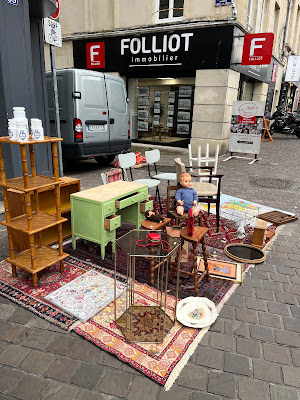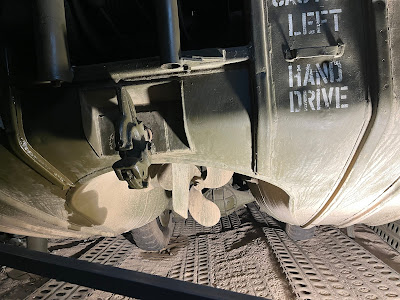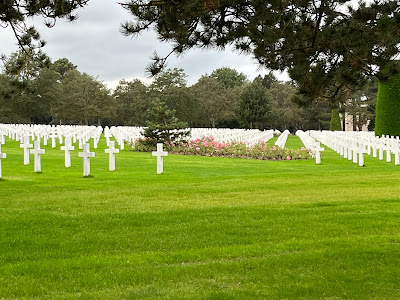We were up way to late last night, so we slept in and eventually got a start to go explore Omaha Beach where the Americans landed on D-day. As we walked down the street to the parking garage for the car, we stumbled upon a farmers market/flea market. There were a lot of fresh veggies, meats and cheeses, and some pretty random flea market antiques.
I loved the old wooden croquet set.
We knew we had to get gas in the car and set off for a filling station not too far away. When I pulled the car out, Delaney noticed a small pool of oil under the car. We had been getting an oil pressure light the day before, but she googled it and people had posted that their oil light would come on when they went around roundabouts (which was when we got the warning light), so we had assumed it was a glitch. After seeing the oil drips, we decided we'd better get more serious about. We successfully filled our tank (we were worried the card would require a pin or something to pay, but it didn't). Then we pulled into the *giant E-leclerc store and opened the hood. Delaney checked the oil and it was low, so we went into the store and found the oil we needed (plus a funnel from the kitchen goods section). We added a liter and saved the rest. No more oil light, even going around roundabouts. We were ready for the road again.
There are over 95 museums, memorials, historic sites, etc all along the coast, so it was tough to decide where to go. In the end we went to the Operation Overlord Museum in Collville-de-mer because it was near the American cemetary. It was a pretty cool museum with a lot of preserved tanks, motercycles, trucks and landing boats. The exhibit included both German, American and British models.
This was one of the amphibious landing vehicles. It kind of looked like a pontoon boat with wheels. The propeller was hidden in between the two parts of the hull.
This is a "Schutzenpanzerwagen". It was found in a scrap yard in 1975. It is one of only 10 known remaining ones today out of 750 that were made during the war.
This monster "artillery tractor" was used by the Germans to tow their largest guns. Two of them together could be used as tow trucks for their Panther and Tiger tanks when they were broken down. This one was restored in 2006 and is one of only two working models today out of 12 remaining units. The picture below is the front end. You can see the front grill is taller than a person.
I was surprised that the history of specific vehicles could be traced in some instances. This half track truck (back axle was treads) was abandoned by the Germans near Falaise as the Canadian forces advanced in 1944. Later claimed by a cider producer, it was used to haul apples into the 1970s.
I particularly liked the exhibits of every day items that the troops carried with them.

I found the instructions on the bar of soap funny: This soap can be used in soft, hard, and salt water at any reasonable temperature for toilet use, shaving, laundering of clothes, and cleaning of messkits and similar equipment.
This was another piece of equipment with a very specific history. Its the tail wheel from a Messerschimtt. The exhibit notes had the name of the pilot of the plane (shot down on 7 June 1944) and the name of the Polish fighter pilot who shot him down. The history seems so long ago, but there were pretty detailed records that were kept even in the midst of the fighting.
My favorite part of the exhibit were the personal stories of photos at the end. Many had the serviceman's photo and a later photo when they had returned to visit the beaches later in life. They all had firsthand accounts of their experiences on the beaches in 1944. Very moving. The one that was the saddest to read was from a black American serviceman who shared how the white members of his unit hated him and the Germans hated him and he was constantly walking on eggshells to avoid abuses from members of his own unit and trying to avoid getting killed by the Germans.
When I finally dragged Delaney away from the museum late in the afternoon, we headed up the road to the cemetary. It was a spectacular view of the beaches. The cemetary was on the bluffs overlooking the beaches.
There are 9,388 American soldiers buried here. The land has been permanently given to the US to maintain in perpetuity. The remains were originally at a nearby site, but were re-interred at this location later.
Over a million people visit the site every year. I was glad to be here on a quiet day with only a handful of people around us. We were not allowed to stroll through the rows, but did get a closer view along one of the walkways.
We didn't have a lot of time at the cemetary before it closed for the day. We decided to drive along the coast to see a few more of the bunkers and views. We were way off the beaten path, driving through tiny little villages on single lane roads. It was quite beautiful! I was thankful for google maps.
This is looking west up Omaha beach.
This is one of the bunkers we found. It must have been a large artillery installation. The trenches were still very visible along the top of the cliff.
After seeing the cliff installations, we decided to head to the small manmade port of Port-en-Bessin-Huppain. The tides along the coast go up and down 10-15 meters and low tide is quite far out from the cliffs. At this location, they put in a concrete jetty to shelter a cove and lots of small motor boats (and a few sailboats) were grounded on the sand there (the tide was out). It was clear from the high water mark that the tide came up quite a bit to float these boats.
The shore was a little more rugged here. This is looking east toward Juno landing where the British came ashore. The darker areas are seaweed. There are TONS of large seashells here.
My favorite shot for the day. The sunset was beautiful over the bay.
You can see the high tide mark on the wall.
I have no idea what the concrete blocks used to be that were now making up the jetty, but they were enormous and looked kind of like puzzle pieces. I don't know what their original purpose was, but I think they were reused here.
We had showers off and on throughout the day. The rainbow at sunset was fun!
The particularly cool feature of this artificial harbor however, was not the jettys and the beaches pleasure boats, but the lock that enclosed the local river and prevented the tide from going out in part of the harbor. All the deeper water fishing boats came through the lock at high tide and then the lock was closed, keeping them afloat as the water drained in the rest of the harbor during low tide. Pretty ingenious.
All the big boats are afloat in the inner harbor while the tiny boats are grounded beyond the lock.
Dinner at a river front cafe. I had the local galette Normande - a crepelike pancake with camembert, sausage, and apple. Pretty tasty.
Tide is about halfway up and boats are floating again.


































No comments:
Post a Comment